Czym jest analiza przypadków użycia?
Diagramy przypadków użycia są głównie używane do opisywania ról oraz połączeń między rolami a przypadkami użycia. Wyjaśnij, kto będzie korzystał z systemu i co mogą z nim zrobić.
Diagram przypadków użycia zawiera wiele elementów modelu, takich jak systemy, uczestnicy i przypadki użycia, oraz pokazuje różne relacje między tymi elementami, takie jak generalizacja, asocjacja i zależność.
Pokazuje diagram modelu funkcjonalnego systemu, który może być obserwowany przez zewnętrznego użytkownika. Przypadki użycia pomagają zespołowi deweloperskiemu zrozumieć funkcjonalne wymagania systemu w sposób wizualny.
Elementy diagramu przypadków użycia
Diagram przypadków użycia zawiera 6 elementów, a mianowicie
- Aktor
- Przypadki użycia
- Asocjacja
- Relacje include
- Relacje rozszerzone (Extend)
- Relacja generalizacji
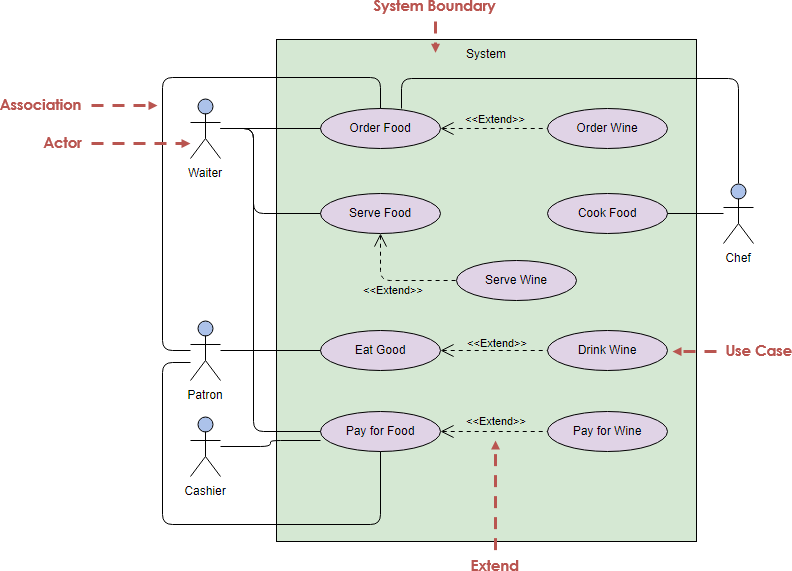
Alternatywnie, możesz umieścić granice systemu w diagramie przypadków użycia, aby wskazać zakres systemu.
Aktor
Jakie są role, które korzystają z tego systemu? Różne role korzystają z różnych funkcji systemu, które są reprezentowane przez aktorów w diagramie przypadków użycia.
- Zewnętrzny podmiot
- Uczestniczyć w procesie realizacji przypadków użycia
- Aktorzy są reprezentowani przez role, które odgrywają w uczestnictwie w przypadku użycia
- Każdy aktor może uczestniczyć w jednym lub więcej przypadkach użycia
Rodzaje aktora
- Użytkownicy systemu – rzeczywiści ludzie, użytkownicy, są najczęstszymi aktorami, którzy istnieją w prawie każdym systemie, i powinni być nazywani zgodnie z rolami
Inne systemy, które wchodzą w interakcję z budowanym systemem - Program zewnętrzny – Przykład, gdy klient nie zwrócił samochodu w czasie zwrotu, system przypomni przedstawicielowi obsługi klienta, aby zadzwonił do klienta, a czas lub zewnętrzny system staje się uczestnikiem systemu
- Inne obejmują urządzenia sprzętowe, usługi zewnętrzne i zewnętrzne bazy danych
Jak znaleźć uczestników systemu?
- Kto będzie korzystał z głównych funkcji systemu
- Kto będzie potrzebował wsparcia systemu, aby wykonać swoją pracę
- Kto będzie musiał utrzymywać i zarządzać systemem
- Jakie urządzenia sprzętowe system musi obsługiwać
- Z jakim systemem ten system wchodzi w interakcję
Inicjator i wspierający
- Kto lub jaki system jest zainteresowany wynikami generowanymi przez ten system
- Inicjator jest głównym obiektem usługi przypadku użycia
Inny to uczestnik, który odgrywa rolę wspierającego
Relacja między przypadkami użycia
Relacja asocjacji (reprezentuje relację między uczestnikami a przypadkami użycia. W UML często jest reprezentowana przez prostą linię lub linię z strzałką wskazującą na odbiorcę informacji)

Strukturyzacja przypadków użycia z relacjami
Relacja Extend / rozszerzenia (oznacza, że nowe zachowania są dodawane do istniejących przypadków użycia w określonych warunkach. Uzyskane nowe przypadki użycia nazywane są rozszerzonymi przypadkami użycia, a oryginalne przypadki użycia nazywane są podstawowymi przypadkami użycia, co odpowiada zapewnieniu dodatkowej funkcji dla podstawowych przypadków użycia. Jest reprezentowana przez przerywane linie z strzałkami w UML, a strzałki wskazują na podstawowe przypadki użycia)
Relacja include (oznacza, że zachowanie innych przypadków użycia może być po prostu włączone, a zachowanie przypadku użycia zawarte w nim można traktować jako część jego własnego zachowania. Często jest reprezentowane przez przerywane linie z strzałkami w UML, a strzałki wskazują na włączone przypadki użycia)
Relacja generalizacji (odnosi się do tego, że rodzicielski przypadek użycia może być specjalizowany, aby utworzyć wiele dziecięcych przypadków użycia, a relacja między rodzicielskimi przypadkami użycia a dziecięcymi przypadkami użycia to relacja generalizacji. W UML jest reprezentowana przez solidną linię z pustą trójkątną strzałką, a strzałka wskazuje na rodzicielski przypadek użycia)
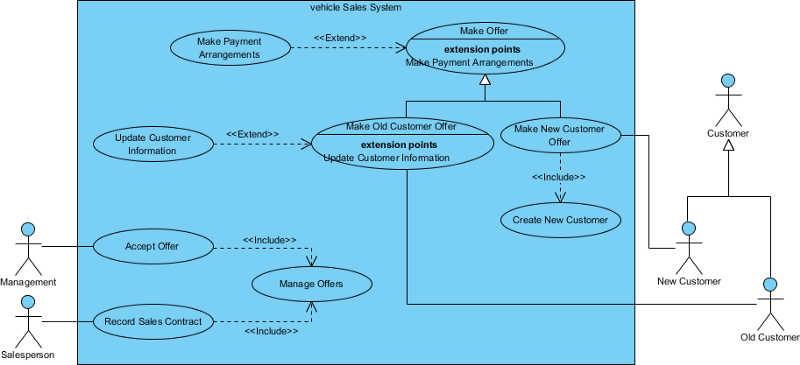
Przykłady przypadków użycia
Tutaj wybieram kilka przykładów z Visual Paradigm Online, które powinny być ci dobrze znane w kontekście biznesowym, takich jak bankomat, DMS i system zamówień. Rysunek poniżej pokazujebankomat przykład diagramu przypadków użycia, który jest dość klasycznym przykładem do wykorzystania w nauczaniu diagramu przypadków użycia.
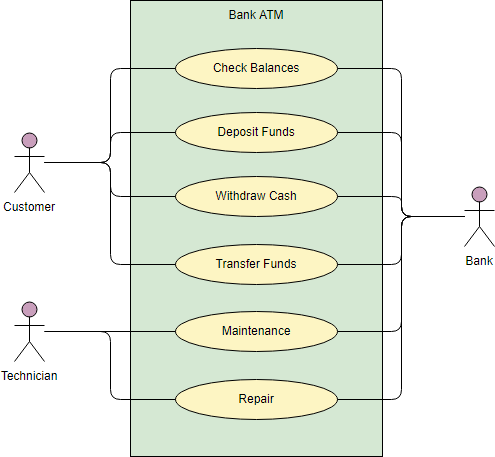
DokumentZarządzania Dokumentami (DMS) przykład diagramu przypadków użycia poniżej pokazuje aktorów i przypadki użycia systemu. W szczególności występują relacje include i extend między przypadkami użycia.
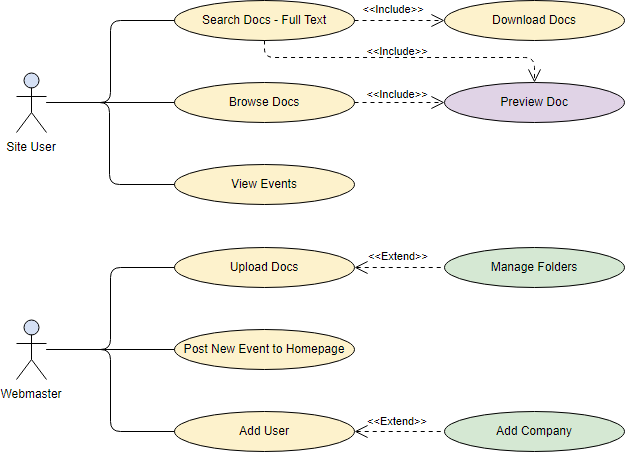
SystemZamówieńPrzykład diagramu przypadków użycia poniżej pokazuje aktorów i przypadki użycia zaangażowane w system:
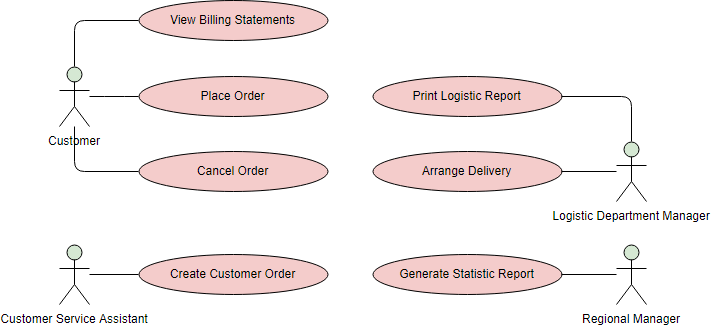
Poznaj inne diagramy UML i pokrewne artykuły
- Dlaczego modelowanie UML?
- Przegląd 14 typów diagramów UML
- Czym jest diagram klas?
- Czym jest diagram komponentów?
- Czym jest diagram wdrożenia?
- Czym jest diagram obiektów?
- Czym jest diagram pakietów?
- Czym jest diagram struktury złożonej?
- Czym jest diagram profilu?
- Czym jest diagram przypadków użycia?
- Czym jest diagram aktywności?
- Czym jest diagram maszyny stanowej?
- Czym jest diagram sekwencji?
- Czym jest diagram komunikacji?
- Czym jest diagram przeglądu interakcji?
- Czym jest diagram czasowy
- Czym jest diagram współpracy UML?
Ten post dostępny jest również w Deutsch, English, Español, فارسی, Français, Bahasa Indonesia, 日本語, Portuguese, Ру́сский, Việt Nam, 简体中文 and 繁體中文













